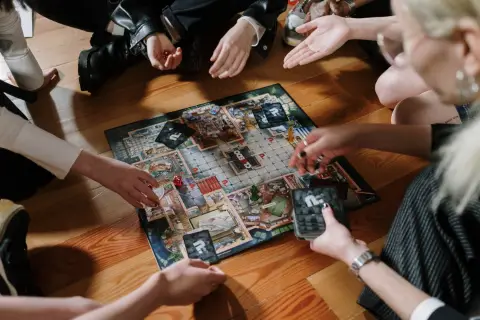Getting together with a group always goes better with a plan. A game night ensures your guests will not be bored and people will engage with one another. If you are considering hosting a game night you want to consider the optimal number of people to include.
The ideal number of participants for a game night is between 4 and 8 players. This range not only provides a balance personalities and skill levels, it also suits the design of most board and party games and ensures everyone gets to be involved. The exact number of people you should include in a game night does vary on several factors including the specific game or games you want to play as well as the reason for your gathering.
Read on as we examine the precise number of guests for various game types and situations!
How many people should you have for a game night?
When planning the perfect game night, the number of participants is a crucial factor to consider. Ideally, aiming for a group size of between 4 and 8 players strikes the perfect balance for a memorable experience.
There are many specific variables that can effect the exact number of people that will best work for your game night. There are many factors to consider, so let’s start by examining the main ones.
Game Selection Flexibility
With 4 to 8 players, the variety of board games and card games available for selection significantly widens. This range accommodates most board games on the market, from classic family favorites to more complex strategy games. In contrast, having fewer than four players can severely limit your options. A large number of games, particularly those designed for group dynamics and interaction, may not be as engaging or even playable with only 2 or 3 participants.
Choosing the right game can be a chore all on its own. If you are looking for help deciding what game to play at your next gathering be sure to take a look at our gudie on game selection.
Complexity and Engagement
Many board games are designed with a 4-8 player dynamic in mind, ensuring that each player remains engaged and active throughout the game. With fewer players, some games become less challenging. This is because these games often rely on player interaction, strategy adaptation, and unpredictability – elements that are diluted with a smaller group.
Social Interaction Balance
A group of 4-8 people allows for lively interaction and banter without overwhelming individual voices. It’s a sweet spot where everyone can contribute to the conversation and feel involved. This size also supports diverse team configurations and alliances, adding an extra layer of fun to games that involve negotiation, bluffing, or cooperative play.

Communicating & Explaining Rules
On the flip side, if you have more than eight players, the dynamics change considerably. Larger groups face challenges in communication and keeping everyone engaged. It can be particularly tough to find games that support more than eight players while still providing an engaging experience.
Additionally, explaining rules and ensuring everyone is on the same page becomes more cumbersome with larger groups. Games that cater to larger numbers often have simpler rules or mechanics to accommodate this, but this can sometimes lead to a less satisfying gaming experience for enthusiasts who enjoy more complex games.
Game Length and Pace
The pace of the game and the overall game length can be perfectly moderated with 4-8 players. Games designed for this number usually have a well-calibrated pace, keeping the game moving and engaging. With larger groups, games can drag on or become chaotic, while with smaller groups, they might end too quickly or lack depth.
Real Data: The Right Amount of People for a Game Night
Another approach to determining the ideal size of your game night is to reach out and ask your potential guests. What are their thoughts and feelings?
I actually did just that. I polled a group of friends to get some real data about the perfect number of people for a game night. I gave respondents a choice of 2-9 or more people. Here is what I found out:
What is the optimal number of players for a game night?

As you can see in the chart, 57 percent of those we questioned considered four players to be the optimal amount of participants for a game night. The rest of the responses were evenly split among 2, 5, and 6 players.
Again, these results are personal preference, but it does provide some insight into what others are thinking. A four player game night makes sense for many different games and does not limit you much when it comes to the game type you can choose.
Average Number of Players for Popular Board and Card Games
If you have a specific games or a game type in mind, this will definitely affect the ideal number of player. Obviously, different games will have a recommended number of players or range of players but we can look at the average number of players for different games to make sure you include enough people to play a variety of games without getting overcrowded.
Board Games
We analyzed over 100 different board games in different genres. We found that the average number of players needed for a board game is 3. With the range of 2-4 players working for the majority of board games.

Card Games
We also looked at some traditional card games. After examining over 150 different types of card games we determined that the average number of players is 4. With the most common range being 2-4 players.
Using this information, it is easy to say that 4 people is the perfect number for a game night but there is still personal preference or the overall goal of you game night to consider. For example, a group of four allows you to play in pairs for team competition. A group of eight allows you to have multiple tables of teams and rotate after games are over.
A group larger than four can also be a great way to instruct newbies. If you have some experienced players and want to get a few more friends up to speed without wasting time. You can pair up a beginner with someone who knows the rules. They can learn as you play and gradually become more involved.
Number of Players for Specific Game Night Scenarios
I think the best way to determine the best number of players for a game night is to consider your specific scenario. What game or games do you have in mind? What kind of players will come? Beginners, advanced, people really into a certain niche? Is this for casual conversation and fun or is this about real competition?
Let’s look at some specific scenarios and the number of players that would work well.
Scenario: Strategic and Complex Games
For games that have a steep learning curve the number of players you need may not be to different from other scenarios, but the specific people you invite will matter. Depending on your social circle, it can be difficult to come up with a large group of players to take on a challenging game with a steep learning curve.
Scenario: Large Parties
On the other hand, if your goal is to throw a more social and casual gathering around some party games like ‘Pictionary’ or ‘Cards Against Humanity’ your options are open. Plus these games can be fun with larger groups, usually around 6-10 players. These games are less about strategy and more about social interaction and fun. This makes them ideal for a party atmosphere where not everyone is there looking for intense strategy and immersion.
Scenario: Niche Interests
For groups with specific interests, like science fiction or fantasy, games such as Dungeons & Dragons or Lords of Waterdeep can be great. However, finding people ready to put in the work to learn the rules or develop characters may limit the size of your gathering.
Balancing Group Dynamics
Remember, the key to a successful game night is balancing the group dynamics with the nature of the games. Consider the preferences and experience levels of your guests, and choose games that will keep everyone engaged and entertained. Whether it’s a strategic battle of wits or a lighthearted party game, tailoring the number of players to the type of game will ensure everyone has a memorable time.

